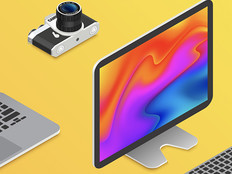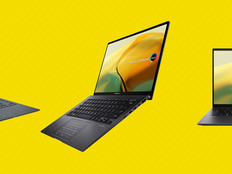A Look into the Future
Inkless printers, palm vein biometrics, open-air holographic images: No, these are not technologies featured in an upcoming sci-fi movie but some innovations that could make your life easier and help your business run more efficiently.
Here’s a sneak peak at five technologies— most still in development — that will have techies drooling when they hit the markets.
Xerox Inkless Printer
Xerox is developing a new printing technology that does not require ink of any kind. The new printers make use of reusable paper that can be printed and erased dozens of times and have the potential to revolutionize printing. Although the technology is still in the early stages of development, it possibly could cut printing costs and reduce office paper use dramatically.
In 2003, Xerox Research Centre of Canada began work on a new type of paper that can be written on and erased simply by applying a certain wavelength of light to it. The idea behind the development of this technology is the possibility of creating paper that can hold information for a short period of time and be reused time and time again.
So far the Xerox team has been able to write and re-write about 50 times on each sheet of paper using a modified multifunction printer. The printer includes a special ultra-violet light, which is used to write on the special paper. No ink of any kind is used in the process, and the resulting printed pages do not smudge or smear when touched. The pages do degrade over time and currently last between 16 and 24 hours before returning to their original blank form. Xerox is now looking for ways to better control the degradation process. If this process can be impeded and the ability to manually erase the paper maintained, Xerox can truly claim to have revolutionized printing.
MRAM
In July 2006, Freescale Semiconductor announced the first commercial availability of MRAM — a new type of memory with the potential to surpass most existing types in speed, power consumption and durability.
Conventional RAM memory pairs transistors and capacitors to create memory cells that each represent one bit of data (0 or 1). The memory cells are aligned in columns and rows, which have intersections known as addresses and where information is stored. Reading and writing information occurs by measuring or changing the charge at a specific address accordingly.
MRAM works differently, more like the read/write head of a hard drive. But unlike a hard drive, which includes mechanical parts (the moving arm holding the read/write head and the rotating plates on which the information is stored), MRAM is a solid-state device and, as such, allows high speed and durability.

Like conventional RAM, MRAM is composed of transistors, but instead of electrical charges, it uses magnetic charges to store information. An MRAM chip is made up of millions of pairs of tiny ferromagnetic plates (such as those covering hard drives) called memory cells, i.e., magnetic sandwiches consisting of two magnetic layers separated by a thin insulating layer.
Each magnetic layer has a polarity — a north pole and a south pole. These can be oriented in a parallel orientation, where both have their respective poles (or “magnetic moments”) in the same orientation, or in an anti-parallel fashion, where their poles (magnetic moments) are oriented in opposite directions. These relative magnetic pole orientations correspond to the binary memory states — either 0 or 1.
Although MRAM has many advantages over virtually every existing memory type, it is still in its infancy. Many had hoped MRAM would usher in the age of instant-on computers, which would be able to replace the main memory and hard drives, but its costs have kept MRAM from making the leap from dream to reality. At $25 per 0.5 megabytes, MRAM has no chance of competing with existing RAM at for $25 per 256MB, not to mention Flash at $25 per gigabyte. The only place where MRAM might be widely applied is in specialized markets, for example, as a battery-backed SRAM replacement. Only when the price comes down (possibly with more advanced lithographic technology than its current 0.18 microns) will MRAM’s unique qualities gain widespread appeal.
Fujitsu’s Palm Vein Biometric Technology
For several years, Fujitsu has been developing a new type of biometric technology expected to be more secure, reliable and possibly less intrusive than current biometric systems. Palm vein identification technology uses an infrared sensor to capture a user’s unique vein pattern.
On the basis of testing the technology on more than 70,000 people, Fujitsu reported a false rejection rate of 0.01 percent (i.e., only one out of 10,000 scans were incorrect denials for access) and a false acceptance rate of less than 0.00008 percent (i.e., incorrect approval for access in one in more than 1 million scans).
But take note: If you register your profile with your right hand, you can’t log in with your left — the patterns of a person’s two hands differ. But if you register your profile as a child, there’s no need to worry because it will still be recognized as you grow because an individual’s vein patterns of are set in utero.
The new technology has many potential applications (some already in use), such as providing ultra-secure systems for automated teller machines and banking transactions; protecting PCs, handhelds or server login systems; locking down authorization systems for front doors, schools, hospital wards, storage areas and high-security areas in airports; and facilitating library lending by doing away with the age-old library card system.
HP Memory Spot Chip
Hewlett-Packard recently unveiled a tiny wireless chip prototype capable of storing and transmitting data. When the new chip hits the market in about two years, it will support a variety of applications, ranging from digital wristbands that store patient medical information to the storage of digital documents or images pictures that can be accessed using reader-equipped devices.
The memory spot chip is basically a miniature computer with onboard memory and wireless capability. It has six main parts: processor, memory, memory driver, modem, capacitor array and loop antenna. HP engineers were able to squeeze all these parts into a chip smaller than a grain of rice (2- to 4-millimeters square).

The chip’s main purpose is to optimize data flow and storage. The wireless capability of the new chip is unique and developed to perform very specific tasks. When the chip was introduced, many were quick to compare it to radio frequency identification technology. Although there are similarities between the two, HP says that the memory spot will compliment, not replace, RFID technology.
Heliodisplay
Floating in midair, an image hovers above a seemingly ordinary table. This convincing open-air holographic-like image is the result of unique mid-air projector developed by a former architect.

The Heliodisplay creates a particle cloud by passing the surrounding air through a heat pump, which in turn cools the air to a level below its dew point, where it condensates, and is then collected to create an artificial cloud. The particle cloud is composed of a vast number of individual micro droplets — between 1 to 10 microns in diameter and too small to be visible to the human eye — held together by surface tension. The focus and illumination intensity of the projected image can be controlled by changing some of the cloud’s properties to create a sharper and brighter image.
The M3-series, released in early 2007, represents the latest Heliodisplay. At close to $20,000, this one of a kind projector is intended primarily for corporate customers.






